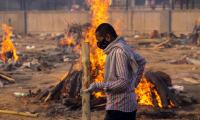PESHAWAR: A thick smog enveloped several cities across Khyber Pakhtunkhwa on Sunday, which has not only worsened the air quality but also affected traffic and is causing diseases.
According to Sulaiman Shah, duty forecasting officer at the regional Met Office, the layer of smog would prevail in different cities of the province for at least a week. However, it may fade away with the downpour, he told The News.
The officer said there was a forecast of light showers tonight and rain on November 14 and 15, which was expected to improve the situation. He said that it was smog that caused diseases like influenza, throat and chest infection.
“It was different from fog, which is a layer of water droplets. Smog on the other hand consists of gases, dust and other particles in the air,” he informed. Earlier reached for comments, Ijaz Ahmad, director of the Met Office, said that he was at the airport leaving for somewhere. He advised the reporter to visit his office today (Monday) to collect information.
With the onset of smog in Khyber Pakhtunkhwa, Peshawar was ranked as the third most polluted city in the country. Charsadda, Mardan and others were also affected by smog. The motorway remained closed for hours until midday due to poor visibility.
“The air quality index (AQI) in Peshawar hit a hazardous 613 around 10 am on Sunday, according to data from Swiss environmental monitoring group IQAir. This places Peshawar among the most polluted cities worldwide, surpassed only by Lahore, which continues to top global pollution charts. The toxic air plaguing KP is reportedly drifting in from neighboring India, exacerbating an already severe smog situation in the region,” IQAir website says.
Levels of PM2.5 pollutants, the fine particulate matter most harmful to human health, reached a staggering 382.2 micrograms per cubic meter in Peshawar, 76.4 times higher than the World Health Organization’s (WHO) recommended safe limit. The Swiss air quality monitor has classified the city’s AQI of 587 as “hazardous,” a level that poses severe health risks, particularly for vulnerable populations.
Residents in various districts across Khyber Pakhtunkhwa reported widespread health issues, including eye and throat irritation and respiratory difficulties. With no immediate relief in sight, officials are urging citizens to take precautions, avoid outdoor activities when possible, and wear masks to mitigate health risks.
PTI workers at a public gathering in this undated picture. — AFP/FileMULTAN: Pakistan Tehreek Insaf has announced...
The newly elected chairperson of the Free and Fair Election Network , Mukhtar Javed seen in this image, released on...
Awami National Party KP president Mian Iftikhar Hussain addresses the Provincial Council meeting at Bacha Khan Markaz...
This combo of images shows the spokesman for the KP government and Adviser to the CM on Information, Barrister...
This representational image shows flame on the stove. — Unsplash/ FileMANSEHRA: The residents on Friday urged the...
Supporters of former prime minister Imran Khan participate in a protest against his arrest, in Peshawar, May 9, 2023....







